A Flexible Solid-State Marx Modulator Module Based on Discrete Magnetic Coupling Drivers
Abstract
:1. Introduction
2. The Structure of a Stackable S2M3
3. Operation Principle of Proposed S2M3
3.1. Switching Timing Sequence under Pulse Modulation
3.2. The Working Process of Proposed Driver
3.3. Simulation of Proposed Driver
4. Experimental Results
5. Conclusions
- (1)
- The proposed driver uses a magnetic coupling method instead of an optical signal for pulse control there is no need for a separate power source for isolating. As a consequence, the volume and cost of the modulator can be reduced.
- (2)
- Discrete magnetic coupling drivers have the ability to output long pulse widths and synchronous or delayed driving of all solid-state switches, enabling the pulse generator to change the pulse shape.
- (3)
- The negative gate voltage amplitude can be adjusted to prevent MOSFET parasitic conduction and ensure its reliable turn-off, and the positive gate voltage amplitude of charging switches can be controlled for soft start.
- (4)
- S2M3 has a compact structure and simple communication between modules; the maximum voltage endured by each driver in each S2M3 and its interference intensity to the controller remain constant when modules are serially stacked to generate higher voltage, which facilitates cascading and expansion of voltage and current parameters in the future.
- (5)
- At present, the output parameters obtained are as follows. The prototype has a voltage amplitude up to 5.45 with 100 within the continuation and 2.8 within the burst. The pulse shapes can be altered, and the pulse width is continuously adjustable within 100 to 50 .
Author Contributions
Funding
Data Availability Statement
Conflicts of Interest
References
- Rao, X.; Chen, X.; Zhou, J.; Zhang, B.; Alfadhl, Y. Design of a high voltage pulse generator with large width adjusting range for tumor treatment. Electronics 2020, 9, 1053. [Google Scholar] [CrossRef]
- Rezanejad, M.; Sheikholeslami, A.; Adabi, J. Modular switched capacitor voltage multiplier topology for pulsed power supply. IEEE Trans. Dielectr. Electr. Insul. 2014, 21, 635–643. [Google Scholar] [CrossRef]
- Redondo, L.M.; Silva, J.F. Flyback versus forward switching power supply topologies for unipolar pulsed-power Applications. IEEE Trans. Plasma Sci. 2009, 37, 171–178. [Google Scholar] [CrossRef]
- Mei, T.T.; Gao, M.; Wang, Y.; Huang, Y.F.; Chu, P.K. Effects of acid treatment and plasma micromachining on the surface properties of carbon fibers. Appl. Surf. Sci. 2022, 592, 153261. [Google Scholar] [CrossRef]
- Yan, Z.; Yin, L.; Hao, C.; Liu, K.; Qiu, J. Synergistic effect of pulsed electric fields and temperature on the inactivation of microorganisms. AMB Express 2021, 11, 47–62. [Google Scholar] [CrossRef] [PubMed]
- Pirc, E.; Miklavčič, D.; Uršič, K.; Serša, G.; Reberšek, M. High-frequency and high-voltage asymmetric bipolar pulse generator for electroporation based technologies and therapies. Electronics 2021, 10, 1203. [Google Scholar] [CrossRef]
- Florkowski, M.; Blaszczyk, P.; Klimczak, P. Partial discharges in twisted-pair magnet wires subject to multilevel PWM pulses. IEEE Trans. Dielectr. Electr. Insul. 2017, 24, 2203–2210. [Google Scholar] [CrossRef]
- Yang, J.; Zhuang, L.; Feng, Y.; Sugai, T.; Jiang, W. Feedback control of pulsed-power generator based on solid-state linear transformer driver. Rev. Sci. Instrum. 2021, 928, 084704–084711. [Google Scholar] [CrossRef]
- Jiang, S.; Shi, H.; Wang, Z.; Wang, Y.; Wu, Z.; Li, Z.; Rao, J. A bipolar modular multilevel generator based on half-bridge and special full-bridge for electroporation applications. IEEE Trans. Plasma Sci. 2021, 49, 1920–1927. [Google Scholar] [CrossRef]
- Elgenedy, M.A.; Darwish, A.; Ahmed, S.; Williams, B.W. A transition arm modular multilevel universal pulse-waveform generator for electroporation applications. IEEE Trans. Power Electron. 2017, 32, 8979–8991. [Google Scholar] [CrossRef]
- Zhong, Z.Y.; Rao, J.F.; Liu, H.T.; Redondo, L.M. Review on solid-state-based Marx generators. IEEE Trans. Plasma Sci. 2021, 49, 3625–3643. [Google Scholar] [CrossRef]
- Rocha, L.L.; Silva, J.F.; Redondo, L.M. Marx multilevel bipolar modulator dynamic models for load transient analysis. IEEE Trans. Plasma Sci. 2017, 45, 2611–2617. [Google Scholar] [CrossRef]
- Rocha, L.L.; Silva, J.F.; Redondo, L.M. Seven-level unipolar/bipolar pulsed power generator. IEEE Trans. Plasma Sci. 2016, 44, 2060–2064. [Google Scholar] [CrossRef]
- Rocha, L.L.; Silva, J.F.; Redondo, L.M. Multilevel high-voltage pulse generation based on a new modular solid-state switch. IEEE Trans. Plasma Sci. 2014, 42, 2956–2961. [Google Scholar] [CrossRef]
- Yao, C.; Zhang, X.; Guo, F.; Dong, S.; Mi, Y.; Sun, C. FPGA-controlled all-solid-state nanosecond pulse generator for biological applications. IEEE Trans. Plasma Sci. 2012, 40, 2366–2372. [Google Scholar] [CrossRef]
- Kandratsyeu, A.; Sabaleuski, U.; Redondo, L.; Pakhomov, A.G. Four channel 6.5 kV, 65 A, 100 ns-100 us generator with advanced control of pulse and burst protocols for biomedical and biotechnological applications. Appl. Sci. 2021, 11, 11782. [Google Scholar] [CrossRef]
- Mi, Y.; Wan, H.; Bian, C.; Peng, W.; Gui, L. An MMC-based modular unipolar/bipolar high-voltage nanosecond pulse generator with adjustable rise/fall time. IEEE Trans. Dielectr. Electr. Insul. 2019, 26, 515–522. [Google Scholar] [CrossRef]
- Liu, Y.; Fan, R.; Zhang, X.; Tu, Z.; Zhang, J. Bipolar high voltage pulse generator without H-bridge based on cascade of positive and negative Marx generators. IEEE Trans. Dielectr. Electr. Insul. 2019, 26, 476–483. [Google Scholar] [CrossRef]
- Fan, R.; Wang, Y.; Zhang, X.; Tu, Z.; Zhang, J. Parameterized nanosecond pulse realization through parametrical modulation of timing sequence of switches in Marx circuit. IEEE Trans. Plasma Sci. 2019, 47, 4096–4104. [Google Scholar] [CrossRef]
- Park, S.-M.; Song, S.-H.; Jo, H.-B.; Jeong, W.-C.; Jang, S.-R.; Ryoo, H.-J. Solid-state pulsed power modulator for 9.3 GHz 1.7 MW X-band magnetron. IEEE Trans. Ind. Electron. 2021, 68, 1148–1154. [Google Scholar] [CrossRef]
- Li, Z.; Liu, H.T.; Jiang, S.; Rao, J.F. A new driving circuit with delay trigger for the solid-state Marx modulators. IEEE Trans. Plasma Sci. 2021, 49, 1906–1914. [Google Scholar] [CrossRef]
- Jo, H.-B.; Song, S.-H.; Lee, S.-H.; Ryoo, H.-J. MOSFET gate driver circuit design for high repetitive (200 kHz) high voltage (10 kV) solid-state pulsed-power modulator. IEEE Trans. Power Electron. 2021, 36, 10461–10469. [Google Scholar] [CrossRef]
- Zhou, Z.; Li, Z.; Rao, J.; Jiang, S.; Sakugawa, T. A high-performance drive circuit for all solid-state Marx generator. IEEE Trans. Plasma Sci. 2016, 44, 2779–2784. [Google Scholar] [CrossRef]
- Gao, L.; Wang, D.; Qiu, J.; Liu, K. All-solid-state pulse adder with bipolar high voltage fast narrow pulses output. IEEE Trans. Dielectr. Electr. Insul. 2011, 18, 775–782. [Google Scholar] [CrossRef]
- Zeng, W.; Yao, C.; Dong, S.; Wang, Y.; Ma, J.; He, Y.; Yu, L. Self-triggering high-frequency nanosecond pulse generator. IEEE Trans. Power Electron. 2020, 35, 8002–8012. [Google Scholar] [CrossRef]
- Yan, J.; Shen, S.; Ding, W. High-power nanosecond pulse generators with improved reliability by adopting auxiliary triggering topology. IEEE Trans. Power Electron. 2020, 35, 1353–1364. [Google Scholar] [CrossRef]
- Rao, J.; Song, Z.; Wang, Y.; Song, J.; Li, Z. Sub-microsecond high voltage pulse power supply based on magnetic isolated driving. High Power Laser Part. Beams 2021, 33, 171–177. [Google Scholar]
- Canacsinh, H.; Redondo, L.M.; Silva, J.F. New solid-state Marx topology for bipolar repetitive high-voltage pulses. In Proceedings of the 2008 IEEE Power Electronics Specialists Conference, Rhodes, Greece, 15–19 June 2008; pp. 791–795. [Google Scholar]
- Wu, F.; Zhao, L.; Dong, S.; Zhou, X.; Zeng, W.; Yao, C.; Yu, L. Magnetic coupling resonant-based air-Isolated module for high voltage pulse generators. IEEE Trans. Ind. Electron. 2023, 70, 2431–2439. [Google Scholar] [CrossRef]
- Abadi, M.R.Q.R.; Marzebali, M.H.; Abolghasemi, V.; Anisi, M.H. High-voltage pulse generators for electroporation applications: A systematic review. IEEE Access 2022, 10, 64933–64951. [Google Scholar] [CrossRef]
- Xie, L.; Ruan, X.; Ye, Z. Equivalent Noise Source: An Effective Method for Analyzing Common-Mode Noise in Isolated Power Converters. IEEE Trans. Ind. Electron. 2016, 63, 2913–2924. [Google Scholar] [CrossRef]
- Zeng, W.; Yu, L.; Dong, S.; Ma, J.; Wang, Y.; He, Y.; Wang, X.; Yao, C. A novel high-frequency bipolar pulsed power generator for biological applications. IEEE Trans. Power Electron. 2020, 35, 12861–12870. [Google Scholar] [CrossRef]
- Li, Z.; Liu, H.; Jiang, S.; Guo, L.; Rao, J. A high-current all-solid-state pulse generator based on Marx structure. IEEE Trans. Plasma Sci. 2020, 48, 3629–3636. [Google Scholar] [CrossRef]
- Redondo, L.M.; Zahyka, M.; Kandratsyeu, A. Solid-state generation of high-frequency burst of bipolar pulses for medical applications. IEEE Trans. Plasma Sci. 2019, 47, 4091–4095. [Google Scholar] [CrossRef]
- Elgenedy, M.A.; Massoud, A.M.; Ahmed, S.; Williams, B.W.; McDonald, J.R. A modular multilevel voltage-boosting marx pulse-waveform generator for electroporation applications. IEEE Trans. Power Electron. 2019, 34, 10575–10589. [Google Scholar] [CrossRef]
- Shi, H.Z.; Lu, Y.D.; Gu, T.Y.; Qiu, J.; Liu, K.F. High-voltage pulse waveform modulator based on solid-state Marx Generator. IEEE Trans. Dielectr. Electr. Insul. 2015, 22, 1983–1990. [Google Scholar] [CrossRef]
- Veilleux, E.; Ooi, B.T.; Lehn, P.W. Marx dc–dc converter for high-power application. IET Power Electron. 2013, 6, 1733–1741. [Google Scholar] [CrossRef]
- Rao, J.; Zhang, R.; Shi, F.; Zhuang, L.; Ji, Z.; Zhuang, J. A high-voltage solid-state Marx generator with adjustable pulse edges. High Volt. 2023, 1–11. [Google Scholar] [CrossRef]
- Lin, L.; Lin, Y.; He, Z.; Chen, Y.; Hu, J.; Li, W. Improved nearest-level modulation for a modular multilevel converter with a lower submodule number. IEEE Trans. Power Electron. 2016, 31, 5369–5377. [Google Scholar] [CrossRef]
- Laird, I.; Yuan, X. Analysing the crosstalk effect of SiC MOSFETs in half-bridge arrangements. In Proceedings of the 2019 IEEE Energy Conversion Congress and Exposition (ECCE), Baltimore, MD, USA, 28 November 2019; pp. 367–374. [Google Scholar]
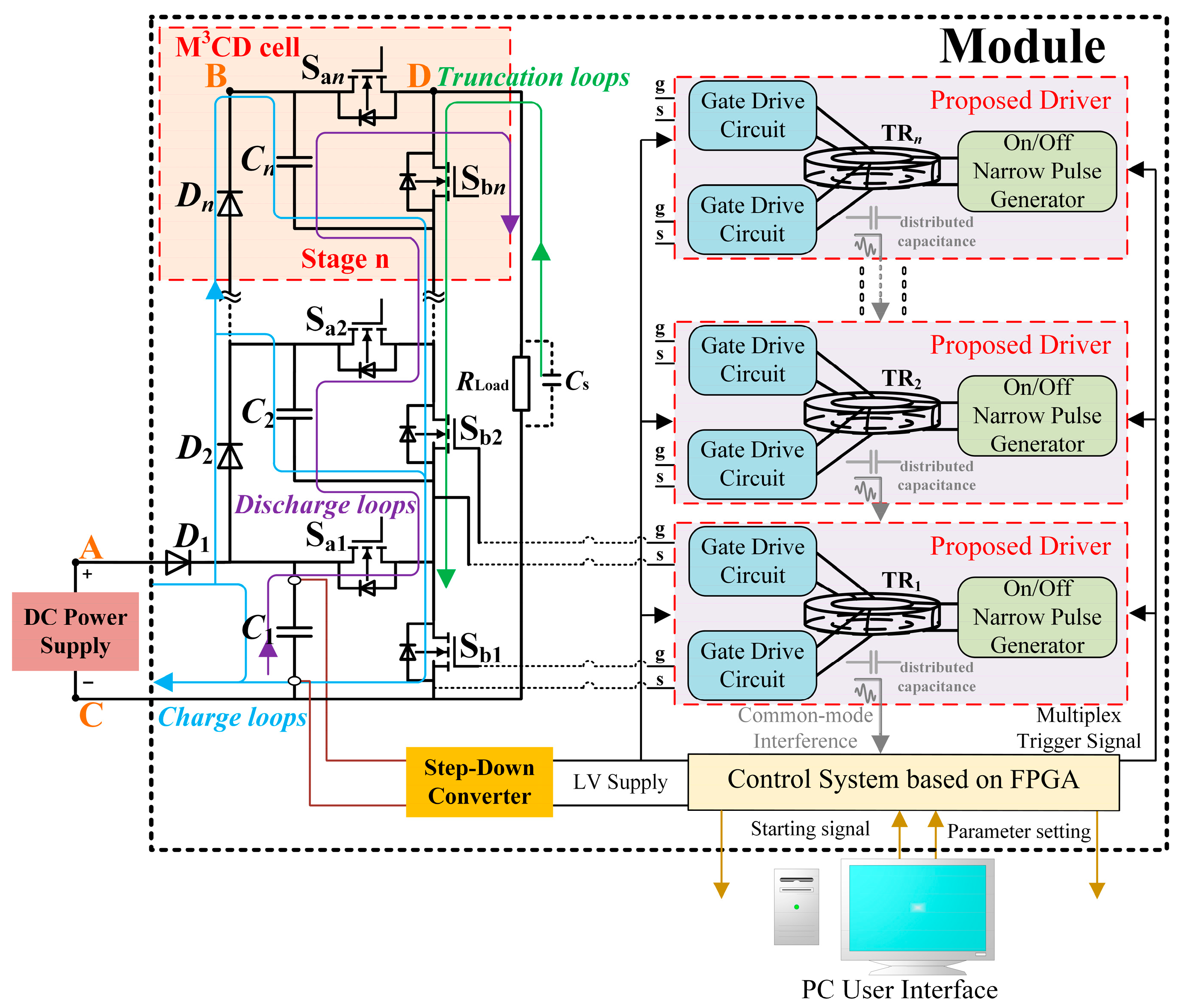
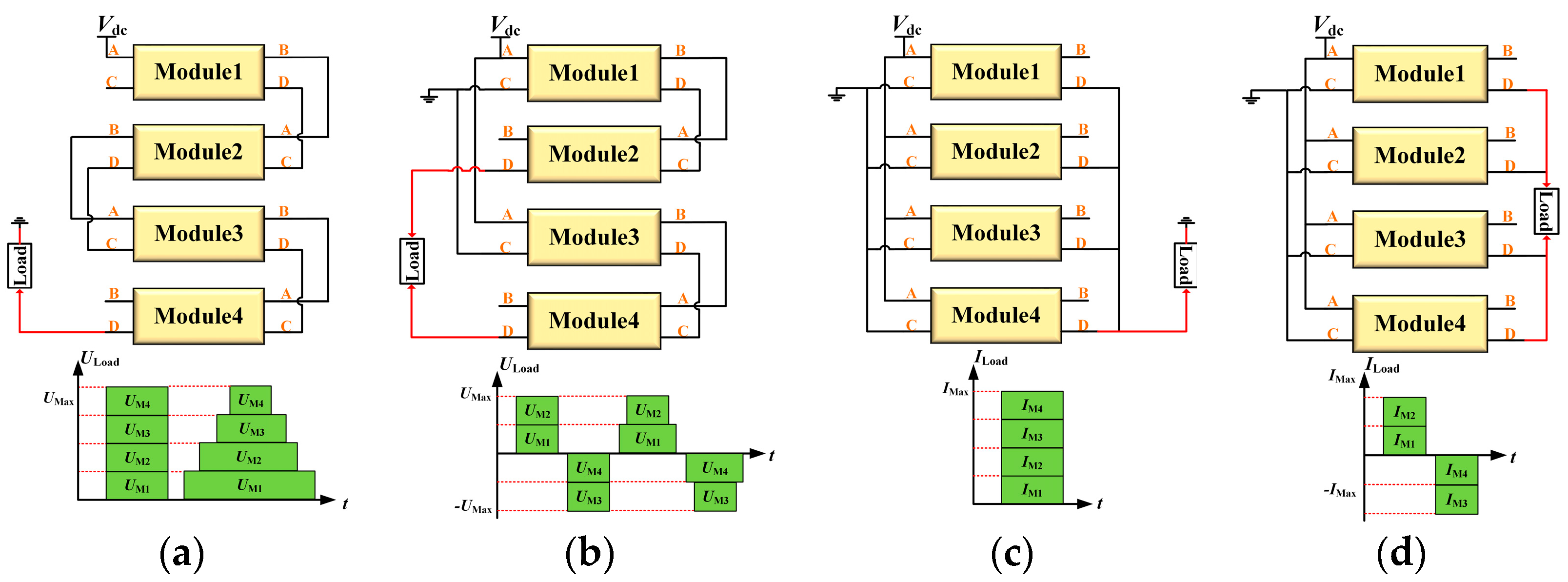

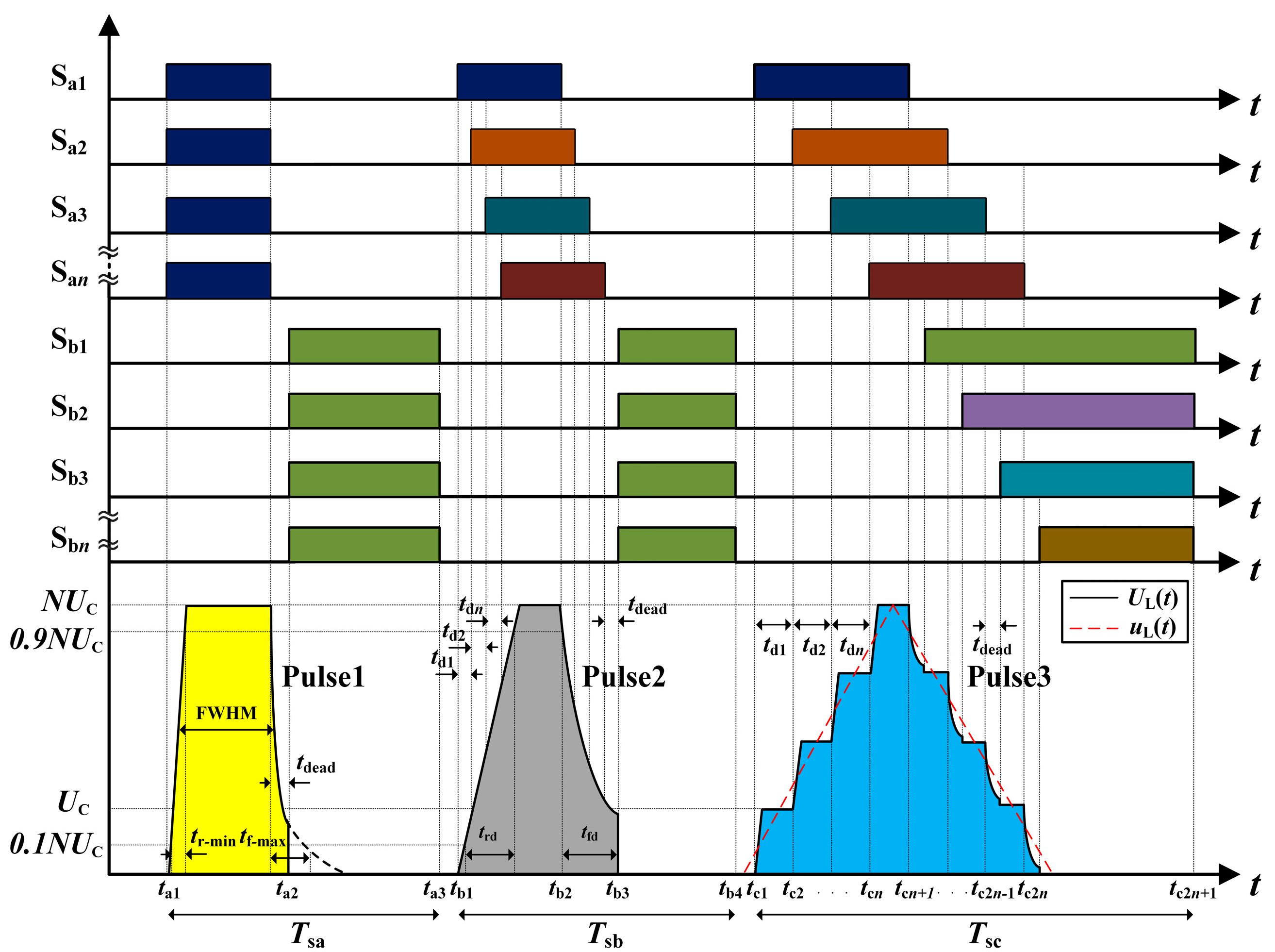
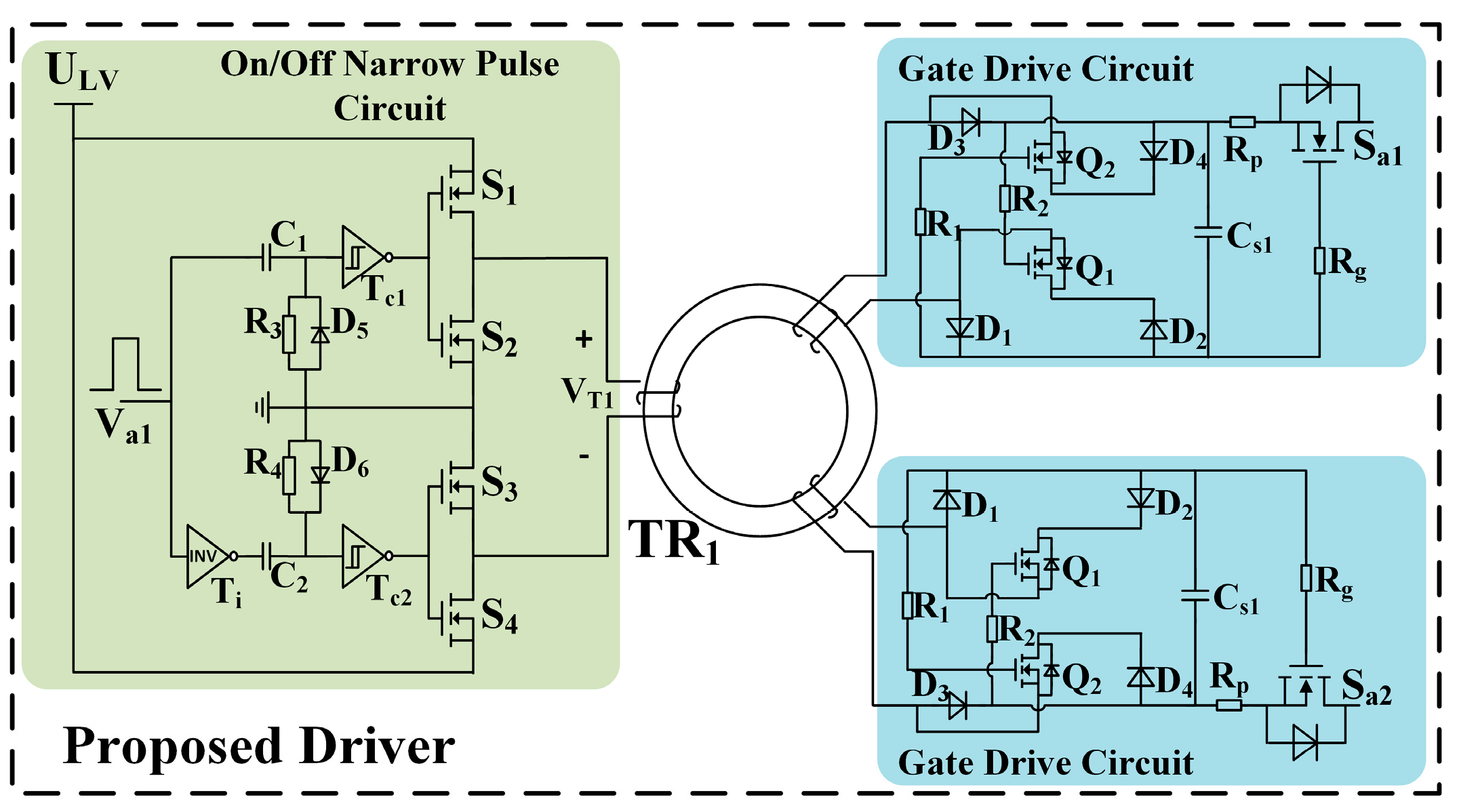
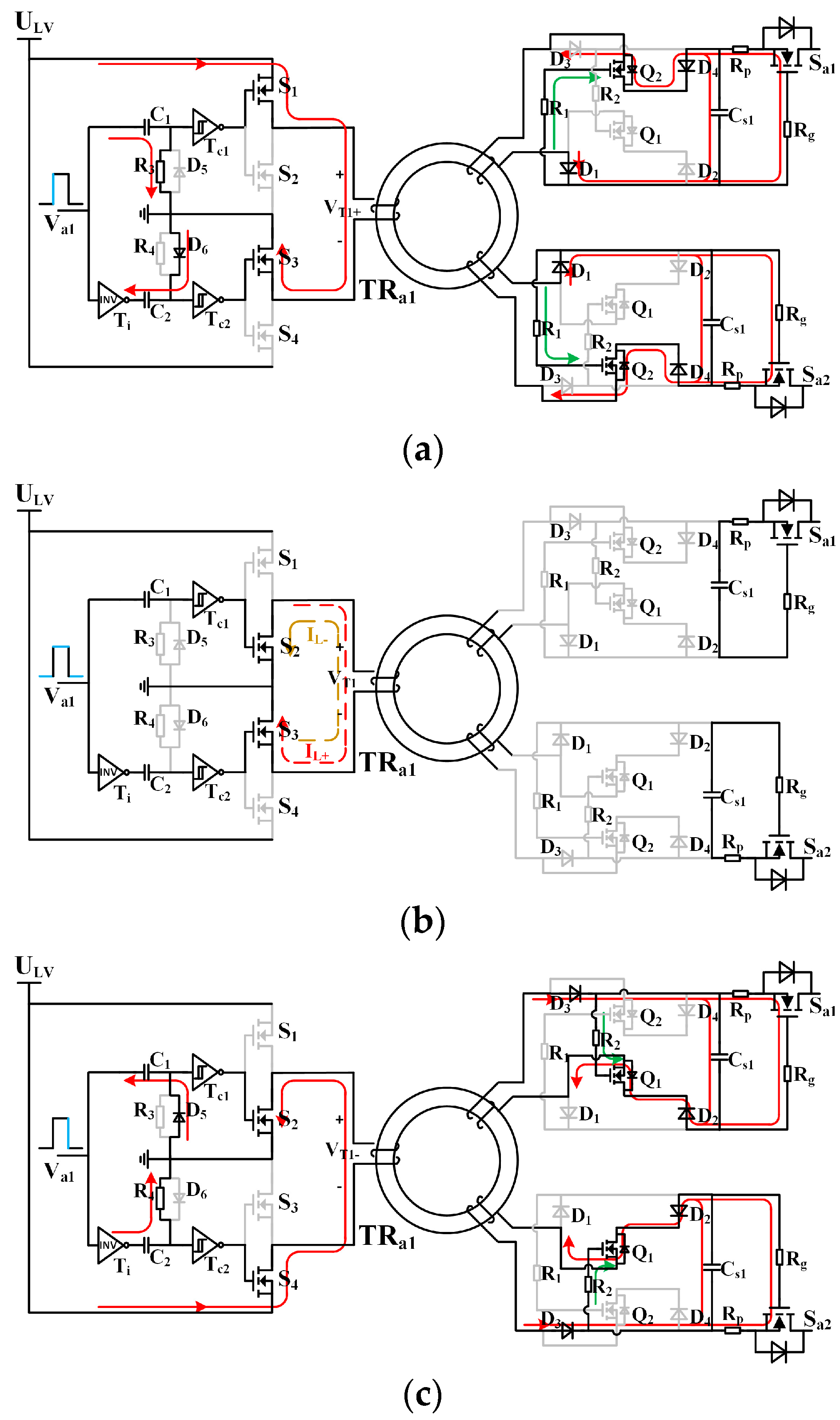
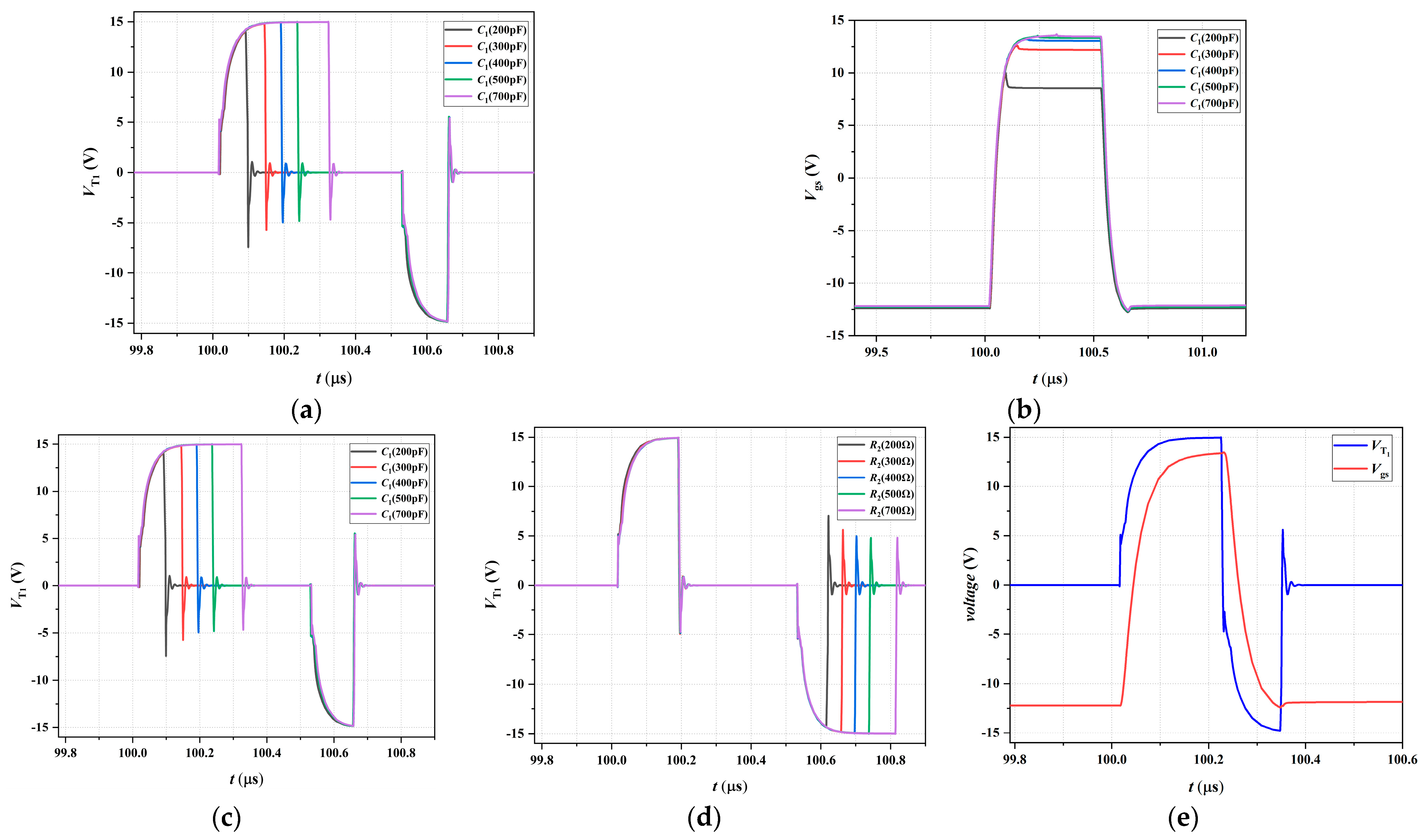


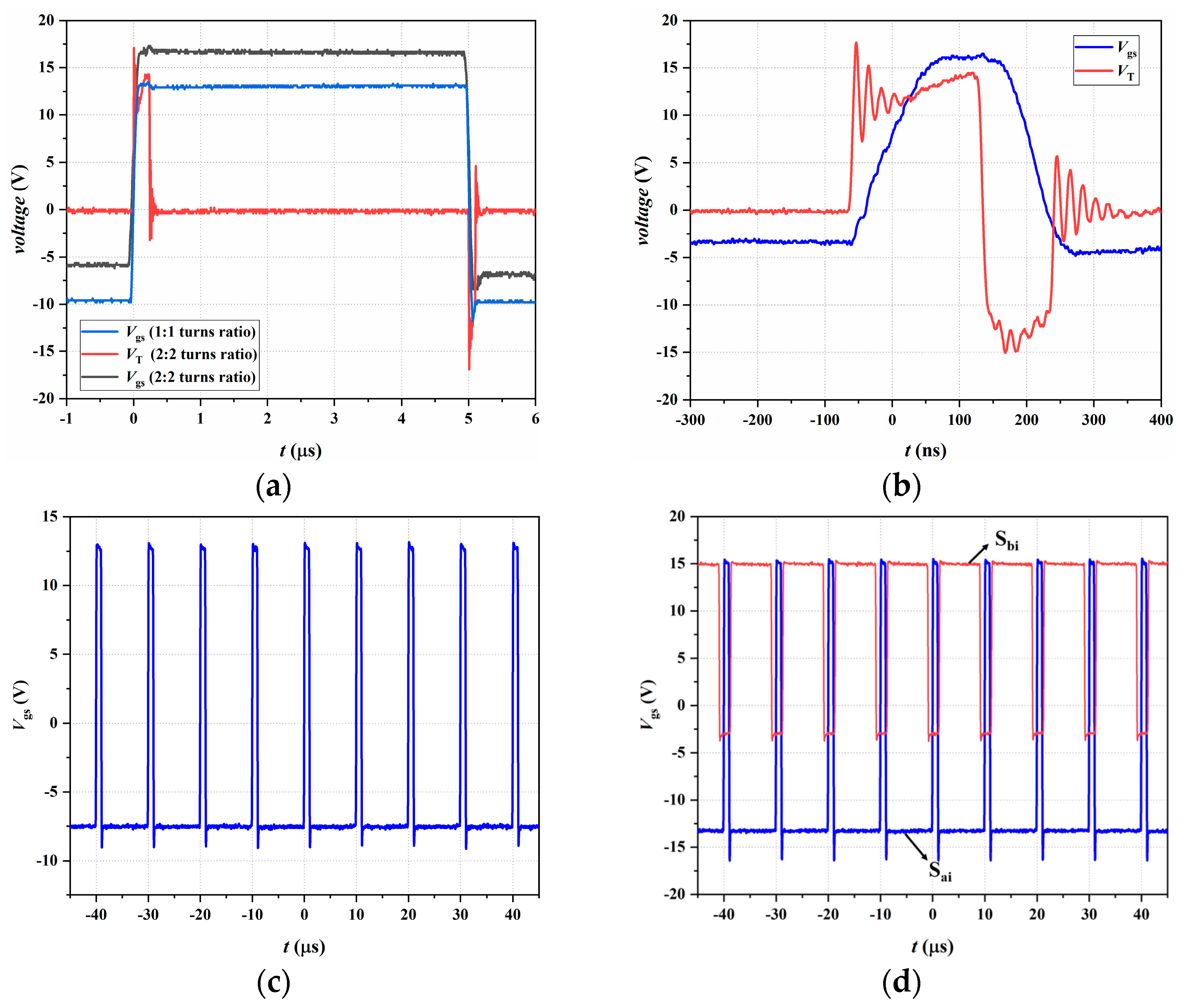
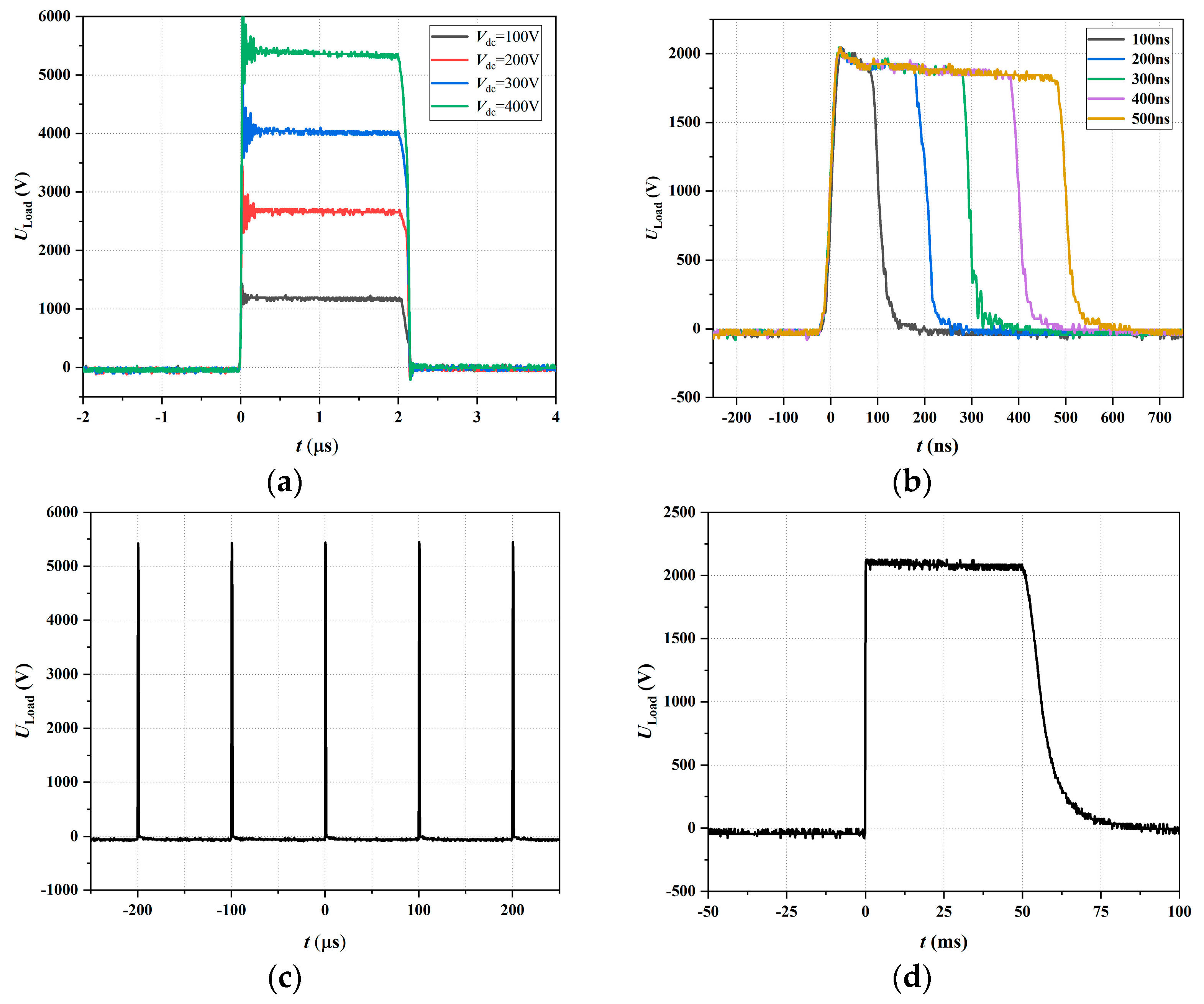
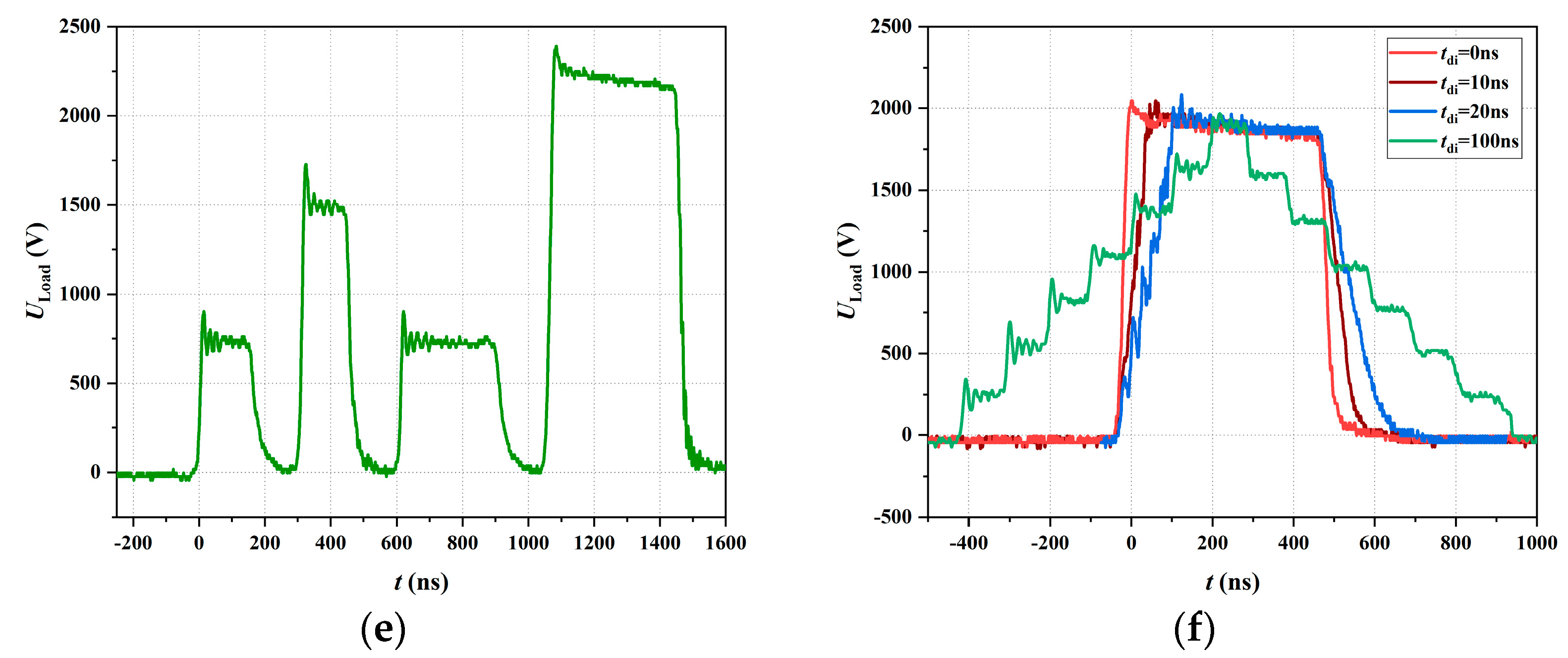
| Type of Drivers | Non-Isolated Power Supply | Independent Control of All Switches | Insulation Reliability | Low Cost | Low Volume | Ref |
|---|---|---|---|---|---|---|
| Optocoupler driver | × | √ | + | ++ | ++ | [16] |
| Optical fibers driver | × | √ | +++ | + | + | [9,15,17,18,19] |
| Series-core magnetic coupling driver | √ | × | +++ | +++ | +++ | [20,21,22,23,24] |
| Self-triggered driver | √ | × | +++ | +++ | +++ | [25,26] |
| Opto-magnetic driver | √ | √ | ++ | + | + | [27] |
| Proposed driver | √ | √ | ++ | +++ | +++ |
| Parameter | Value |
|---|---|
| , | 1 |
| , | 3 |
| 3 | |
| 0.08 |
Disclaimer/Publisher’s Note: The statements, opinions and data contained in all publications are solely those of the individual author(s) and contributor(s) and not of MDPI and/or the editor(s). MDPI and/or the editor(s) disclaim responsibility for any injury to people or property resulting from any ideas, methods, instructions or products referred to in the content. |
© 2023 by the authors. Licensee MDPI, Basel, Switzerland. This article is an open access article distributed under the terms and conditions of the Creative Commons Attribution (CC BY) license (https://creativecommons.org/licenses/by/4.0/).
Share and Cite
Chen, L.; Zhu, C.; Zheng, J.; Qiu, J.; Zhao, H.; Liu, K. A Flexible Solid-State Marx Modulator Module Based on Discrete Magnetic Coupling Drivers. Electronics 2023, 12, 3831. https://doi.org/10.3390/electronics12183831
Chen L, Zhu C, Zheng J, Qiu J, Zhao H, Liu K. A Flexible Solid-State Marx Modulator Module Based on Discrete Magnetic Coupling Drivers. Electronics. 2023; 12(18):3831. https://doi.org/10.3390/electronics12183831
Chicago/Turabian StyleChen, Lei, Caihui Zhu, Jiaming Zheng, Jian Qiu, Hui Zhao, and Kefu Liu. 2023. "A Flexible Solid-State Marx Modulator Module Based on Discrete Magnetic Coupling Drivers" Electronics 12, no. 18: 3831. https://doi.org/10.3390/electronics12183831






